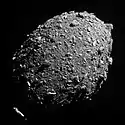TOI-1227 b
TOI-1227 b is one of the youngest transiting exoplanets discovered (as of September 2022), alongside K2-33b and HIP 67522 b. The exoplanet TOI-1227 b is about 11±2 Myrs old and currently 9.5 R🜨 large. It will become a 3-5 R🜨 planet in about 1 billion years, because the planet is still contracting. TOI-1227 b orbits a very low-mass star every 27.36 days.[1]
| Discovery[1] | |
|---|---|
| Discovered by | THYME (Mann et al.) |
| Discovery date | 2022 |
| Transit Method | |
| Orbital characteristics | |
| 0.0886+0.0054 −0.0057 AU | |
| Inclination | 88.571+0.062 −0.093 ° |
| Star | Gaia DR2 5842480953772012928 |
| Physical characteristics | |
Mean radius | 0.854+0.067 −0.052 RJ |
Characteristics
TOI-1227 b has a size that is 85% that of Jupiter. No other Jupiter-sized planet was detected around mid- to late M-dwarfs, despite the deep transits such a planet would create. The researchers find that the planet is still hot from its formation and this heat, combined with a hydrogen-dominated primary atmosphere makes the atmosphere of TOI-1227 b inflated. Evolutionary models suggest that TOI-1227 b will eventually evolve into a sub-Neptune within the next billion years.[1]
Future research
Radial velocity follow-up to determine the mass of TOI-1227 b is not possible in the optical, but might be possible in the near-infrared. A less challenging follow-up would be the measurement of the Spin-Orbit-Alignment via the Rossiter-McLaughlin effect.[1]
Host star
TOI-1227 is located north of the globular cluster NGC 4372, but it is much closer to earth than this cluster of stars at a distance of about 101 parsec.[1]
TOI-1227 was first identified as a pre-main-sequence star (PMS star) with the Gaia satellite.[2][3][4] Without this prior identification as a PMS star the exoplanet signal of TOI-1227 b would have been disregarded as an eclipsing binary due to the V-shape of the transit signal.[1]
The host star TOI-1227 is part of a subgroup of the Lower Centaurus Crux OB association, sometimes called B,[4] A0[2] and called Musca group by the scientists that discovered TOI-1227 b. This group was called Musca after the constellation Musca in which most of its members are located.[1]
TOI-1227 has a spectral type of M4.5V to M5V, a mass 17% of the sun and a radius 56% of the sun. The host star is relative faint for a TOI with a V-band magnitude of about 17. The host star shows Lithium in its atmosphere, which should be depleted within 10-200 Myrs for M-dwarfs.[1]
References
- Mann, Andrew W.; Wood, Mackenna L.; Schmidt, Stephen P.; Barber, Madyson G.; Owen, James E.; Tofflemire, Benjamin M.; Newton, Elisabeth R.; Mamajek, Eric E.; Bush, Jonathan L.; Mace, Gregory N.; Kraus, Adam L.; Thao, Pa Chia; Vanderburg, Andrew; Llama, Joe; Johns-Krull, Christopher M. (2022-04-01). "TESS Hunt for Young and Maturing Exoplanets (THYME). VI. An 11 Myr Giant Planet Transiting a Very-low-mass Star in Lower Centaurus Crux". The Astronomical Journal. 163 (4): 156. arXiv:2110.09531. Bibcode:2022AJ....163..156M. doi:10.3847/1538-3881/ac511d. ISSN 0004-6256. S2CID 239024522.
- Goldman, Bertrand; Röser, Siegfried; Schilbach, Elena; Moór, Attila C.; Henning, Thomas (2018-11-01). "A Large Moving Group within the Lower Centaurus Crux Association". The Astrophysical Journal. 868 (1): 32. arXiv:1807.02076. Bibcode:2018ApJ...868...32G. doi:10.3847/1538-4357/aae64c. ISSN 0004-637X. S2CID 119343278.
- Zari, E.; Hashemi, H.; Brown, A. G. A.; Jardine, K.; de Zeeuw, P. T. (2018-12-01). "3D mapping of young stars in the solar neighbourhood with Gaia DR2". Astronomy and Astrophysics. 620: A172. arXiv:1810.09819. Bibcode:2018A&A...620A.172Z. doi:10.1051/0004-6361/201834150. ISSN 0004-6361. S2CID 119078481.
- Kerr, Ronan M. P.; Rizzuto, Aaron C.; Kraus, Adam L.; Offner, Stella S. R. (2021-08-01). "Stars with Photometrically Young Gaia Luminosities Around the Solar System (SPYGLASS). I. Mapping Young Stellar Structures and Their Star Formation Histories". The Astrophysical Journal. 917 (1): 23. arXiv:2105.09338. Bibcode:2021ApJ...917...23K. doi:10.3847/1538-4357/ac0251. ISSN 0004-637X. S2CID 234790391.

